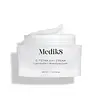What's inside
What's inside
 Key Ingredients
Key Ingredients

 Benefits
Benefits

 Concerns
Concerns

 Ingredients Side-by-side
Ingredients Side-by-side

Cyclopentasiloxane
EmollientIsopropyl Myristate
EmollientDimethicone Crosspolymer
Emulsion StabilisingAscorbic Acid
AntioxidantUbiquinone
AntioxidantHydroxytyrosol
BleachingPinus Pinaster Bark/Bud Extract
AntimicrobialGlycine Soja Oil
EmollientTocopherol
AntioxidantGlycerin
HumectantCaprylic/Capric Triglyceride
MaskingBeta-Carotene
Skin ConditioningBrassica Campestris Seed Oil
Skin ConditioningCitrus Paradisi Peel Oil
MaskingCitrus Aurantium Dulcis Peel Oil
MaskingCitrus Aurantium Bergamia Fruit Oil
MaskingCitrus Aurantifolia Oil
CleansingVanillin
MaskingCedrus Atlantica Bark Oil
MaskingHeliotropine
MaskingSilica
AbrasiveWater
Skin ConditioningStearic Acid
CleansingCitric Acid
BufferingCyclopentasiloxane, Isopropyl Myristate, Dimethicone Crosspolymer, Ascorbic Acid, Ubiquinone, Hydroxytyrosol, Pinus Pinaster Bark/Bud Extract, Glycine Soja Oil, Tocopherol, Glycerin, Caprylic/Capric Triglyceride, Beta-Carotene, Brassica Campestris Seed Oil, Citrus Paradisi Peel Oil, Citrus Aurantium Dulcis Peel Oil, Citrus Aurantium Bergamia Fruit Oil, Citrus Aurantifolia Oil, Vanillin, Cedrus Atlantica Bark Oil, Heliotropine, Silica, Water, Stearic Acid, Citric Acid
Water
Skin ConditioningHeptyl Undecylenate
EmollientCaprylic/Capric Triglyceride
MaskingTetrahexyldecyl Ascorbate
AntioxidantMethylpropanediol
SolventCetearyl Olivate
Cetearyl Isononanoate
EmollientDistarch Phosphate
AbsorbentTocopheryl Acetate
AntioxidantSodium Polyacrylate
AbsorbentSorbitan Olivate
EmulsifyingSodium Hyaluronate
HumectantCaprylyl Glycol
EmollientGlycerin
HumectantDisodium EDTA
Phenylpropanol
MaskingCitrus Grandis Peel Oil
MaskingCitrus Limon Peel Oil
MaskingCitrus Aurantium Bergamia Fruit Oil
MaskingPelargonium Graveolens Flower Oil
MaskingSodium Hydroxide
BufferingLimonene
PerfumingCitronellol
PerfumingLinalool
PerfumingGeraniol
PerfumingCitral
PerfumingWater, Heptyl Undecylenate, Caprylic/Capric Triglyceride, Tetrahexyldecyl Ascorbate, Methylpropanediol, Cetearyl Olivate, Cetearyl Isononanoate, Distarch Phosphate, Tocopheryl Acetate, Sodium Polyacrylate, Sorbitan Olivate, Sodium Hyaluronate, Caprylyl Glycol, Glycerin, Disodium EDTA, Phenylpropanol, Citrus Grandis Peel Oil, Citrus Limon Peel Oil, Citrus Aurantium Bergamia Fruit Oil, Pelargonium Graveolens Flower Oil, Sodium Hydroxide, Limonene, Citronellol, Linalool, Geraniol, Citral
Ingredients Explained
These ingredients are found in both products.
Ingredients higher up in an ingredient list are typically present in a larger amount.
This ingredient is an emollient, solvent, and texture enhancer. It is considered a skin-softener by helping the skin prevent moisture loss.
It helps thicken a product's formula and makes it easier to spread by dissolving clumping compounds.
Caprylic Triglyceride is made by combining glycerin with coconut oil, forming a clear liquid.
While there is an assumption Caprylic Triglyceride can clog pores due to it being derived from coconut oil, there is no research supporting this.
Learn more about Caprylic/Capric TriglycerideCitrus Aurantium Bergamia Fruit Oil is the oil from the bergamot orange. It is native to Italy.
This ingredient is used to add fragrance to products. It contains limonene, linalool, and linalyl acetate.
The term 'fragrance' is not regulated in many countries. In many cases, it is up to the brand to define this term. For instance, many brands choose to label themselves as "fragrance-free" because they are not using synthetic fragrances. However, their products may still contain ingredients such as essential oils that are considered a fragrance.
When used topically, Citrus Aurantium Bergamia Fruit Oil is a photosensitizer due to its furanocoumarins. Photosensitizers make the skin and eyes much more sensitive to sunlight. Photosensitizers are linked to skin cancer.
However, more cosmetics using Citrus Aurantium Bergamia Fruit Oil are removing the furanocoumarins.
Bergamot oil was also found to have anti-inflammatory, antibacterial and antifungal properties.
Learn more about Citrus Aurantium Bergamia Fruit OilGlycerin is already naturally found in your skin. It helps moisturize and protect your skin.
A study from 2016 found glycerin to be more effective as a humectant than AHAs and hyaluronic acid.
As a humectant, it helps the skin stay hydrated by pulling moisture to your skin. The low molecular weight of glycerin allows it to pull moisture into the deeper layers of your skin.
Hydrated skin improves your skin barrier; Your skin barrier helps protect against irritants and bacteria.
Glycerin has also been found to have antimicrobial and antiviral properties. Due to these properties, glycerin is often used in wound and burn treatments.
In cosmetics, glycerin is usually derived from plants such as soybean or palm. However, it can also be sourced from animals, such as tallow or animal fat.
This ingredient is organic, colorless, odorless, and non-toxic.
Glycerin is the name for this ingredient in American English. British English uses Glycerol/Glycerine.
Learn more about GlycerinWater. It's the most common cosmetic ingredient of all. You'll usually see it at the top of ingredient lists, meaning that it makes up the largest part of the product.
So why is it so popular? Water most often acts as a solvent - this means that it helps dissolve other ingredients into the formulation.
You'll also recognize water as that liquid we all need to stay alive. If you see this, drink a glass of water. Stay hydrated!
Learn more about Water